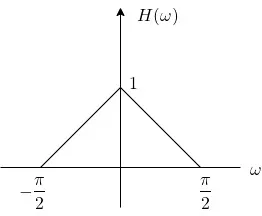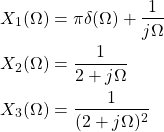
[Image1]
Introduction
Hey it's a me again @drifter1!
Today we continue with my mathematics series about Signals and Systems in order to cover Exercises on Filtering.
So, without further ado, let's dive straight into it!
Filtering Recap
Filtering is based upon the convolution property of the Fourier Transform:

The convolution property of the Fourier Transform allows us to simplify the calculations for LTI Systems (by moving into the Frequency-Domain), but it can also be used as a way of "re-shaping" the input. Depending on the frequency bands which are "allowed" to pass, filters are categorized into low-pass, high-pass and band-pass. An approximation of the ideal filters can be implemented using series R-C circuits and moving average filters.
Filter Properties [Based on 12.1 from Ref1]
Consider a filter with frequency response H(ω) as shown in the following Figure:

Check which of the following properties the filter satisfies:
- Real-valued or Complex-valued
- Even or Odd
- Causal or Non-Causal
Solution
First of all the impulse response is real because:

and so:

The graph of the impulse response reflects across the y-axis, which means that the function is even.
Mathematically:

Last but not least, the impulse response is also non-causal because:

Lowpass, Highpass or Bandpass Filter [Based on 12.5 from Ref1]
Determine the type of filter the following filters correspond to:

and find the frequency responses to validate your answer.
Solution
Examining the mathematical expressions of those filters its easy to notice that y1[n] supresses changes by averaging x[n], whilst y2[n] supresses the frequency bands that have varied (from x[n-1] to x[n]). As such, y1[n] can be thought of as an low-pass filter, whilst y2[n] can be used as a high-pass filter. As the value of k increases we suspect that the changes will be supressed further.
The Fourier Transforms of these two simple cases can be calculated using properties, which easily gives us the following frequency responses:

For k = 2, and in the range [-2π, 2π] the first filter closes up to zero at +-π, whilst the second filter has a value of zero at 0, +-2π. As such, the first filter is closer to a low-pass filter, whilst the second filter is closer to a high-pass filter.
Filter Output [Based on 12.8 from Ref1]
Consider a filter with the following impulse response:

Calculate the frequency response H(Ω) and determine the filter output for the following input signals:

Solution
The impulse response is one of the known FT pairs, and as such the frequency response is:

The Fourier Transforms of the input signals are also in FT pair tables and as such:

The Filter output for each of these cases is:

Getting back to the Time Domain might be quite difficult for the first case, so let's only do this for the second case (which we've done a handful of times) and I will leave the third output as an exercise for the reader. :)
We first have to turn the multiplication into a sum using factor simplification, which gives us the following:

The final result is a sum of two known FT pairs, and so the output is:

RESOURCES:
References
Images
Mathematical equations used in this article were made using quicklatex.
Block diagrams and other visualizations were made using draw.io and GeoGebra
Previous articles of the series
Basics
- Introduction → Signals, Systems
- Signal Basics → Signal Categorization, Basic Signal Types
- Signal Operations with Examples → Amplitude and Time Operations, Examples
- System Classification with Examples → System Classifications and Properties, Examples
- Sinusoidal and Complex Exponential Signals → Sinusoidal and Exponential Signals in Continuous and Discrete Time
LTI Systems and Convolution
- LTI System Response and Convolution → Linear System Interconnection (Cascade, Parallel, Feedback), Delayed Impulses, Convolution Sum and Integral
- LTI Convolution Properties → Commutative, Associative and Distributive Properties of LTI Convolution
- System Representation in Discrete-Time using Difference Equations → Linear Constant-Coefficient Difference Equations, Block Diagram Representation (Direct Form I and II)
- System Representation in Continuous-Time using Differential Equations → Linear Constant-Coefficient Differential Equations, Block Diagram Representation (Direct Form I and II)
- Exercises on LTI System Properties → Superposition, Impulse Response and System Classification Examples
- Exercise on Convolution → Discrete-Time Convolution Example with the help of visualizations
- Exercises on System Representation using Difference Equations → Simple Block Diagram to LCCDE Example, Direct Form I, II and LCCDE Example
- Exercises on System Representation using Differential Equations → Equation to Block Diagram Example, Direct Form I to Equation Example
Fourier Series and Transform
- Continuous-Time Periodic Signals & Fourier Series → Input Decomposition, Fourier Series, Analysis and Synthesis
- Continuous-Time Aperiodic Signals & Fourier Transform → Aperiodic Signals, Envelope Representation, Fourier and Inverse Fourier Transforms, Fourier Transform for Periodic Signals
- Continuous-Time Fourier Transform Properties → Linearity, Time-Shifting (Translation), Conjugate Symmetry, Time and Frequency Scaling, Duality, Differentiation and Integration, Parseval's Relation, Convolution and Multiplication Properties
- Discrete-Time Fourier Series & Transform → Getting into Discrete-Time, Fourier Series and Transform, Synthesis and Analysis Equations
- Discrete-Time Fourier Transform Properties → Differences with Continuous-Time, Periodicity, Linearity, Time and Frequency Shifting, Conjugate Summetry, Differencing and Accumulation, Time Reversal and Expansion, Differentation in Frequency, Convolution and Multiplication, Dualities
- Exercises on Continuous-Time Fourier Series → Fourier Series Coefficients Calculation from Signal Equation, Signal Graph
- Exercises on Continuous-Time Fourier Transform → Fourier Transform from Signal Graph and Equation, Output of LTI System
- Exercises on Discrete-Time Fourier Series and Transform → Fourier Series Coefficient, Fourier Transform Calculation and LTI System Output
Filtering, Sampling, Modulation, Interpolation
- Filtering → Convolution Property, Ideal Filters, Series R-C Circuit and Moving Average Filter Approximations
- Continuous-Time Modulation → Getting into Modulation, AM and FM, Demodulation
- Discrete-Time Modulation → Applications, Carriers, Modulation/Demodulation, Time-Division Multiplexing
- Sampling → Sampling Theorem, Sampling, Reconstruction and Aliasing
- Interpolation → Reconstruction Procedure, Interpolation (Band-limited, Zero-order hold, First-order hold)
- Processing Continuous-Time Signals as Discrete-Time Signals → C/D and D/C Conversion, Discrete-Time Processing
- Discrete-Time Sampling → Discrete-Time (or Frequency Domain) Sampling, Downsampling / Decimation, Upsampling
Final words | Next up
And this is actually it for today's post!
Next time we will get into Modulation examples...
See Ya!

Keep on drifting!
